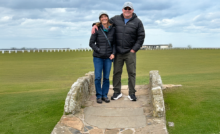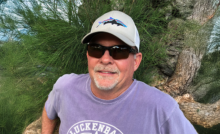Visualizing the final product
One of the most positive traits we all have as golf course superintendents is that of vision. We constantly visualize what it is we need to achieve on our golf courses and we project that vision out much farther than any of our members/patrons could ever imagine. Without this vision, we would be trying to put together a 10,000-piece puzzle without knowing what the final product would look like. Visualizing the final product allows us to try different pieces until we find the right fit. My four years at Northland Country Club have seen us make drastic changes to the nature of our turf which all started with a vision. The vision was there for what the course would eventually become and allowed us to continually work toward the ultimate goal. If a practice is not moving us toward the ultimate goal, we do not spend valuable time continuing the practice.
One of the most important pieces to our puzzle has been the implementation of a deep infrequent irrigation program. Our long-term goal is to manage the Poa annua out of our playing surfaces. When we irrigate, our goal is to completely wet our four- to five-inch sand rootzone with irrigation. We then allow the rootzone to dry down to the point when the bentgrass begins to show moisture stress before the next irrigation cycle is run. We have found that as the rootzone dries, it dries from the top down. During the summer months, within just two to three days, the rootzone has dried past the point of the Poa annua roots while the bentgrass roots still have access to plenty of moisture. Managing our irrigation in this manner gives bentgrass a tremendous advantage over Poa. We have found 60 minutes per head to generally be the runtime we need to achieve our desired wetting of the profile. The wetting of the profile is helped by venting the surfaces every two weeks with 0.220-inch tines, as well as breaking up the 60 minutes into three- to 20-minute cycles. We manage our putting surfaces in this manner without the use of a wetting agent.
While using a deep infrequent irrigation program has worked very well for us, we continue to use our long-term vision to analyze the program and make adjustments. We analyze the results, measure those results against current practices and find ways to tweak said practices with the goal of achieving better results. This summer as we analyzed our management practices on greens and measured the results being achieved when it came to bentgrass, we noticed our driest greens were also the greens with the highest percentage of bentgrass. While all of our management practices are aimed at giving bentgrass a competitive advantage, irrigation management is really the straw that stirs the drink. We were managing the irrigation on our driest greens exactly the way we wanted it to be managed … thus achieving the most positive results on those surfaces. However, the rest of the greens were just along for the ride when it came to irrigation management.
For the past three seasons, our central control computer has been set up with only two green programs covering the golf course … one for the top of the course and one for the bottom of the course. When deciding when to irrigate, the driest greens always set the benchmark. Let me clarify with an example. Our 14th green is an exposed green, which drains well and accepts no water from the surrounding area. Our 18th green is more protected and sits in a bit of a bowl and accepts a lot of moisture from the surrounding area. Four or five days after a deep irrigation cycle, the 14th green is ready for water while the 18th green has only achieved 40 to 50 percent of our desired dry down. We had turned down the runtime percentage on the wetter greens but that was not helping us achieve a full and complete deep irrigation cycle. The question we asked: Why have two greens with very different irrigation needs on the same program?
Analysis is nothing if you do not use it to your advantage. Knowing the type of irrigation cycles we desired and knowing that our current program set-up was only really giving us desired results on a few greens, we decided to take greater advantage of our central control computer. Initially we grouped similar greens to the same programs. This resulted in seven green irrigation programs on our central control computer. This worked better than two programs but we still found the need to irrigate some greens on a program before others. So the next idea was to have a separate program for each putting green. A set-up which now allows us to only irrigate the putting surfaces needing irrigation at a point when they have achieved our desired dry down. Making this change to our programming allows us to take complete advantage of a deep infrequent irrigation program on each and every green. Let’s go back to the example greens of 14 and 18. During the summer months, 14 green typically reaches our desired dry down after just four to five days. With 18 green previously having been on the same program, it would have been watered according to the needs of 14 green, even though its dry down needs were every eight to 10 days. Not only did this keep 18 from truly being watered in a deep infrequent manner, but it also left us using more water than necessary to water the putting surfaces over the entire golf course.
This, of course, begs the question: How do you determine when your putting surfaces truly need to be irrigated? Analysis of our practices also showed us that simply using visuals and or the old probe method was too subjective. Different people’s opinions of “dry” vary greatly, which can produce a lack of consistency. We needed a way to make determining our need for irrigation more objective and less subjective. Enter the Spectrum Technologies TDR 300. I was first introduced to this moisture meter during a visit from USGA agronomist Bob Vavrek during the 2009 season. Then a fellow superintendent purchased his own meter and I felt it was in the course’s best interest to have one, too. Next year we will be using the TDR 300 to take daily moisture readings of all putting surfaces with the goal of determining a moisture percentage by having each green tell us when its time to water.
My feeling is that anything we can do to extend the length of time between irrigation cycles is a big plus. Extending our irrigation intervals not only allows us to manage bentgrass over Poa annua, it also gives us a huge advantage when it comes to managing disease without the use of fungicides. Limiting the number of days our surfaces are wet by irrigation is an absolute key to limiting disease activity and the need to spray. Then there is my favorite benefit … extending irrigation intervals and letting Mother Nature have every opportunity to do the watering for us. In the end, is this not what we all desire?
There is no cookie-cutter method for irrigating golf course turf. What works for us, likely does not or would not work for many. However, having a vision, working toward that vision and making constant and consistent tweaks to your programs is something that can ultimately make everyone more successful.
Contact Chris at
ctritabaugh@northlandcountryclub
or visit his blog at
www.northlandgrounds.blogspot.com
Recent Posts
Memphis Country Club: A Golfer’s Study in Precision and Tradition
If you have ever teed it up at Memphis Country Club, you know this isn’t…
Foley Company attains GCSAA Silver Partner Status
Foley Company, a leader in turf equipment innovation and technology, affirms its support of the…
Harrell’s continues longstanding support of the GCSAA Foundation
Harrell’s LLC, a leading distributor of customized agronomic products for turfgrass since 1941, has donated…
City of Orlando Announces New State-of-the-Art Driving Range at Dubsdread Golf Course
The City of Orlando is excited to announce the construction of a brand-new, state-of-the-art driving…
Discover Puerto Rico for Great Golf Trips and After-Round Activities, Amenities
Golfers cannot live by the game alone which is why Puerto Rico provides the perfect…
Q&A with a Multi-talented Golf Course Architect – Part 2: Making the Rounds – Installment 39
This column features recollections of the author’s 37 years as a golf writer. These installments…



